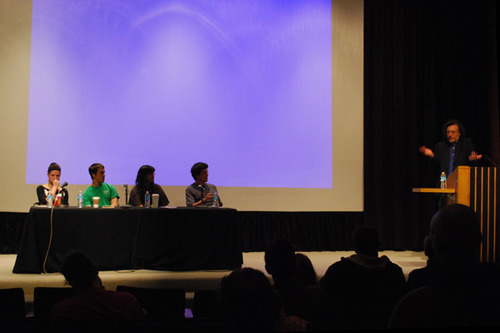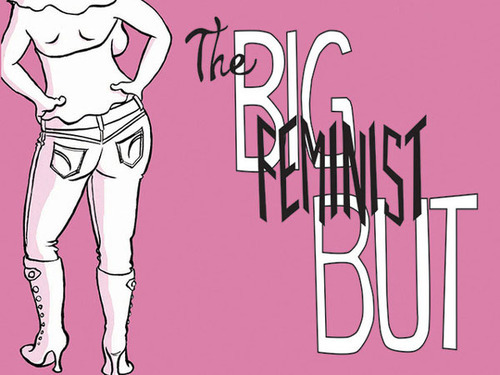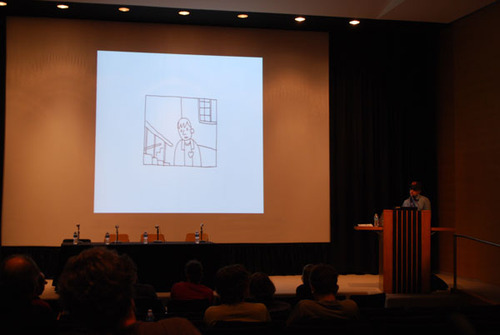the Drawing Power Report
📝This archived post is originally from my old comics focused Wordpress blog from 2011-2019. That site was a space to publicly commit to learning the art and craft of cartooning and self-publishing.
These posts are full of a naive enthusiasm that though at times embarrassing, I'm proud of. I hope you find them useful in some way.❤️
This article was co-written with Simon Reinhardt. It originally appeared at Dog City Press.
__
This past weekend a couple of us from Dog City trekked down from Vermont to Pittsburgh, PA for the Drawing Power conference at the Carnegie Museum of Art.
The museum setting established a wonderful tone for the conference. It was a breath of fresh air to go to an intimate event with such a clear focus on discussing comics.
A big thanks is due to Jude Vachon, zine librarian at the Carnegie Library of Pittsburgh. Vachon was the core organizer of this event and responsible for steering it toward such a success.

The days events ran from 10 AM until 5 PM. Each panel was a jam packed 45 minutes.
The first panel of the day was moderated by Bill Boichel, owner of the Copacetic Comics Company. It focused on the idiosyncrasies of the local Pittsburgh comics scene. The panel consisted of Lizzee Solomon, Andy Scott, Paulette Poullet and Nate Mcdonough.

The panelists spoke about their experiences self-publishing and the role that the Pittsburgh community played in their work practices.
Scott spoke about his anthology, Andromeda and the restructuring of the publication in late 2012 from a monthly to a quarterly format. Solomon spoke about cartooning being at the core of her multi-disciplinary work practices while Nate McDonough retold the beginnings of his_Grixly_ publication.
McDonough, Solomon and Scott spoke of their times drawing together during the early issues of Andromeda and the competitive one-upmanship that their drawing parties would foster.
The panel explored the inroads that the four cartoonists had made into self-publishing and the external factors in their lives that had driven them to continue to self-publish in Pittsburgh.

Following the Pittsburgh cartoonists panel, French cartoonist, Boulet (Gilles Roussel) , author of the 24-hour comic Darkness took the stage to give a lecture on the evolution of his cartooning practices.
He spoke about streamlining his creative process and the increased emphasis on improvisation that he had developed in his work. He spoke about working with Joann Sfar and Lewis Trondheim on the series, Dungeon along with the exquisite corpse comic, Chicou Chicou, that he developed with several French cartoonists.
The aim of Chicou Chicou was to create a fictional “auto-bio” group comics blog. The cartoonists would pass strips back and forth over the internet adding pages until they were complete. Each of the cartoonists involved created a persona and crafted a drawing style that suited their character. Boulet played a small, geeky girl named Ella.
Besides discussing the subtleties of drawing stories from the perspective of a female character, Boulet talked about the harassment he received online when writing under a female pen-name. He reported receiving unsolicited love letters and invitations on dates and noted that when he got into disputes people would ask “are you on your period or something?”
At the end of his talk, Boulet spoke succinctly of his influences and of his current project, a 200 page improvised story in which he is neither pencilling nor scripting. He showed several of the 60 pages that he’d completed and the audience was in awe.
Freelance writer, illustrator and graphic designer, Joan Reilly then took the stage and talked about her work editing the forthcoming feminist anthology, The Big Feminist But. Joan presented the book’s contents and the genesis of the project.

The Big Feminist But arose from Reilly and O’Leary’s attempts to learn why so many of us, women and men, couch discussions around feminism with the phrase “I’m not a feminist, but…” or “I am a feminist, but…”. They decided to embark on the journey of making a comics anthology as the first step in starting a conversation about the issue.
The result is a promising book that features “graphic musings on life, love, lust and liberation,” by talents such as Jeffrey Brown, Gabrielle Bell, and Lauren Weinstein.
The book’s list of contributors is especially notable for including a number of couples working together, as well as single men and women. Reilly mentioned that a number of Kickstarter backers expressed their gratitude that men were involved with the book as well– an observation that highlights The Big Feminist But’s drive to create an expansive and inclusive conversation about feminism.

Subsequently, John Porcellino, took the stage to talk about the story of his life of zine-making and distribution. He talked about the story of King Cat, and the Spit and a Half zine and comix distribution service.
Porcellino touched on his artistic development and the early years of King Cat (focusing on the first 50 issues, collected in King Cat Classix). Porcellino has created books, comics, and publications since he was 7 or 8, and was creating zines for years before he discovered Factsheet 5 and learned that other people were doing it too.
He read some highlights from early King Cat issues and talked about his work processes and goals in creating that work. One revelation from this portion of the talk was the influence of Marvel’s monster comics from the 50s and early 60s.

While the relationship between these fantastic stories and Porcellino’s chronicles of everyday life might not be immediately apparent, Porcellino emphasized the drab, repetitive nature of the monster stories as well as the alienation of their typical mad scientist protagonists. “As an artist I’m very interested in repetition and boredom,” he said.
Porcellino also talked about the sales and distribution history of King Cat, which was instructive for the many self-publishers in the audience. Gesturing to the cover of the first issue of King Cat to be sold in stores, Porcellino noted the 35 cent cover price and remarked “in true zine fashion, I probably charged 35 cents because it cost me 36 cents to print.”
He also talked about his history of working bizarre or menial jobs to support his comics, and pinpointed King Cat issue 42, which he wrote, drew, and edited entirely on company time, as “the point I became a professional cartoonist, because I was being paid to draw comics.”
Porcellino spoke about his interest in the idea of real life and the ineffable experience of being alive. One thing he mentioned—and we think this is a big part of what makes King Cat so special—is that he tried not just to describe the event of his experience, but to communicate the feeling of that experience. Porcellino characterized the subject matter of his comics as “this weird feeling I had… [of] the underlying mystery in every moment,” a description we think King Cat readers will agree is quite fitting.

Caitlin McGurk, librarian at the Billy Ireland Cartoon Library and Museum moderated the following panel on self-publishing. Porcellino remained on stage to join Ramsey Beyer, Rachel Masilamani and Bill Boichel to chat about their experiences self-publishing in the United States.
Similar to the first panel of the day, the panelists spoke of how they’d found their way to comics and more generally towards self-publishing.
Masilamani recounted first encountering zines through Christina Kelly’s zine of the month column in [Sassy magazine](http://www.dogcitypress.com/post/48862327903/(http://en.wikipedia.org/wiki/Sassy_(magazine)). She spoke about the experience of receiving the Xeric grant and the consequences that it brought along with it. It allowed for her to get her first comics into the world and to hit the ground running with her first collection of RPM, but from the get go she was on her own.
The panelists thoughts on the pricing of mini comics were particularly interesting. Not surprisingly, Boichel as a vendor and Porcellino as a distributor had a lot to bring to the discussion of the relationship between self-expression and the commodification of desire. Boichel mentioned that artists sometimes come to him with $20 minicomics, reporting that they sold a lot of copies in New York, but he knows they won’t sell at that price point in Pittsburgh.
Beyer emphasized the importance she placed on the ethics of the production process and mentioned having worked with 1984 Press in Oakland California.
Boichel, suggested that aspiring cartoonists always pick someone to write to; a friend, an acquaintance, a stranger, someone. By thinking of their audience’s interests and their budget, they could be more likely to create works that would move through the world more freely.

Dash Shaw followed the self-publishing panel. He began his talk by showing some recent animation work. One of the most striking animations that he played was the music video,Seraph, which he had made in collaboration with Frank Santoro and other artists for Sigur Ros’ valtari film experiment.
Shaw took the audience through a brief survey of his cartooning work, starting with his three current publications– the minicomic New Jobs, published by Uncivilized Books, the pamphlet3 New Stories, and the graphic novel New School, both published by Fantagraphics– and working his way backward to the mammoth graphic novel Bottomless Belly Button.
One through-line of Shaw’s talk was his thoughts regarding line and color. “I could talk about color forever,” he said, and it’s hard not to get excited by his original and distinctive ideas.
Many of the pages Shaw showed from New School use color in ways that are entirely divorced from traditional comic book coloring. Shaw rarely uses colors to simply fill out the drawing, preferring instead to use the collision between the color and the line-art to create meaning and emotion, often in oblique and subtle ways.
This unwillingness to spell things out directly for the reader was evident in Shaw’s discussion of line and drawing as well. He spoke of being inspired by David Mazzucchelli’s idea of the “dumb line,” (which he describes in more detail here) and by trying to push back against the conventions of “good” illustration.
“So much illustration is about telling people what something is and how to feel about it,” Shaw said, adding that he wanted to make drawings that don’t tell their reader how to feel.
He also spoke about his fascination with the house styles found, among other places, in manga and Archie comics, speculating about an ideal, impossible Archie style. In Shaw’s conception, even the best Archie artists fall short of this Platonic style, and their own personal style would be the accumulation of their failings at achieving a true Archie drawing.
All in all, it was a dense, stimulating talk, and we can’t wait to dive into New School and read it with the attention Shaw’s work demands.

The final panel of the day, “A Career in Comics” was moderated by Caitlin McGurk and featured Jim Rugg, Ed Piskor, Frank Santoro and Dash Shaw.
The fluidity of the discussion was really satisfying. Without much effort it hopped from discussions of style (and avoiding “style”) to explorations of narrative collapse. Of course, a highlight of the panel was the discussion of the differences between making money around comics and making money in comics.
Career development and survival were recurring topics, and every member of the panel had a different way of approaching making a living as a cartoonist. The common thread was work ethic and hustle.
Santoro half-jokingly described himself as “basically a used book dealer at this point.” Rugg spoke about doing design work and also discussed the Flight School fellowship , a professional development program for Pittsburgh artists he recently participated in.
To see the comics medium getting the attention of an established institution like the Carnegie Library of Pittsburgh and for it to occur at the Carnegie Museum was inspiring. Here’s hoping for more small events around the country with this level of intimacy and intensity of dialogue.
all in all, you could say…
